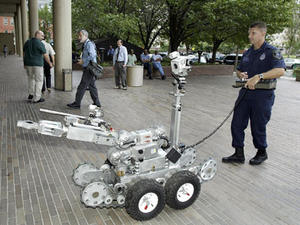TrendFirst response, law enforcement ground robot market to grow
The current market for first responder and law enforcement ground robots is estimated at $203 million; just-published research says that the market is poised for a significant growth; first responder robots cost about $50,000 and up, which is the cost of a person for one year; the challenge for vendors is thus to find applications where the robot is used 24x7 365 days per year

Police increase use of robots // Source: cmoslabs.com
C WinterGreen Research announces that it has a new study on first responder, law enforcement, and homeland security ground robots. The 2010 study has 460 pages, 165 tables and figures.
Worldwide markets will see significant growth as the first responder and homeland security ground robots are used globally. Growth comes as the border patrols and law enforcement agencies use robots to achieve broader security in a less expensive manner, delivering the promise of automated process in yet another industry. First responder robots bring changes in every region while the globally integrated enterprise creates broader cooperative police actions.
This cost is creating resistance among the agencies, but costs of robots are expected to decrease rapidly in the next year, creating a much larger market than exists now. The current market at $203 million does provide a significant base for solid growth.
Salisonline notes that vendors of homeland security and first responder robots are positioned to provide a common framework through which federal, state, local, and tribal governments can address emergencies. U.S. federal first responder agencies are negotiating agreements with state and local government law enforcement groups to share equipment. First responder robots cost $50,000 and up, the cost of a person for one year.
Whereas a person can patrol and investigate, a first responder robot able to sniff for explosives is not justified in high quantity. A few shared units go a long way in detecting explosives.
The challenge for vendors is to find applications where the robot is used 24×7 365 days per year. This is when return is realizes. An exception is an airport and a border patrol crossing point where there is continuous need to sniff for explosives.
First responder and homeland security robots are useful as patrol units. Just as foot police and patrol cars look for dangerous situations, so also a first responder robot can patrol an area with cameras and chemical sensors.
According to Susan Eustis, the lead author of the study, the purchase of first responder and homeland security robots s is dependent on budget constraints. The use of first responder and homeland security robots s is based on providing a robot that is less expensive to put in the field than a trained soldier. That automation of process has appeal to those who run the first responder and homeland security.
Robots are automating first responder and homeland security ground systems, permitting protection of police officers and people in the field, and creating the possibility of reduced fatalities.
